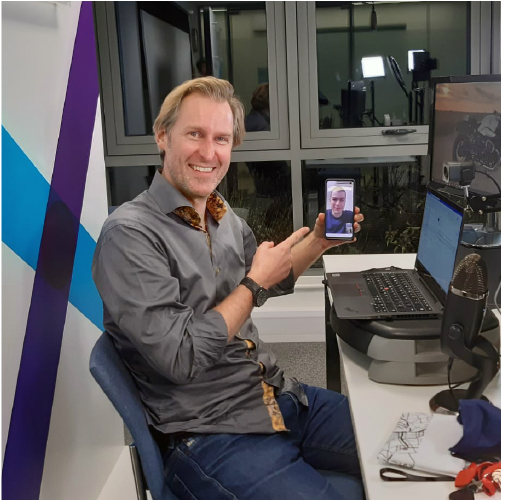What next for events in the world of COVID-19?
on LinkedIn:
The impact of the pandemic has dramatically shaken up the world of conferences and events. Ana Romero, Digital Marketer and Events Coordinator at Cambridge Design Partnership, looks back over a tumultuous year and asks, “what next”?

Here we are, almost exactly a year ago. This is Pharmapack, in Paris. The two-day event was attended by 5,500 delegates and more than 400 exhibitors, and just look at the optimism on our faces! We don’t know it yet, but this is the last physical event we’ll attend before the pandemic descends, forcing us into our spare rooms and at the mercy of Teams, Zoom, and an emerging world of digital-only events.
Welcome to chaos
A month later, in March 2020, the events world was in chaos and turmoil. I was busy contacting the organizers of each event we were planning to attend, checking their websites for updates, following the news and, arranging refunds for cancelled conferences.
Many conference organizers simply announced that they would be cancelling their 2020 offering and would be back in 2021. But others tried to offer a virtual experience. The idea of going online came as a relief to us here at CDP – as we were just as keen as before to share our expertise, to network with our peers, and meet tomorrow’s clients.
However, the transition to digital has been challenging, especially for event organizers dramatically adapting their business model and event delivery in a matter of weeks.
Forget the plan; it’s time to adapt.
So what have we learned? The most immediate learning for us at CDP has been that a good virtual conference is made by enabling the sort of interactions which make a physical conference so valuable. Can you get talking with someone who is visiting the event, develop them into a contact and then, hopefully, a client?
The first virtual conference we attended didn’t work at all. We couldn’t network with other companies, to reach the people we wanted or to strike up any sort of rapport with other attendees. A low bar had been set.
However, in only a few months, I’ve seen many improvements in the different platforms used and some real successes so far. Several virtual conferences we’ve attended during the pandemic have offered far better ways to connect and market to delegates. For example, some platforms allowed us to see and filter the delegate list (by name, role, and company name) and to request a one-to-one meeting with that person. In addition, the ability to watch presentations on demand made it easier to book a video conference during a session slot and later go and watch what we missed, something that wouldn’t have been possible in a real-life event.
Virtual conferences have crystallized how important it is to have your material in a digital and interactive format. We’ve learned to have just enough collateral in the digital booth to initiate a conversation. In a virtual exhibition, it’s easier to visit a virtual booth and fill your virtual goodie bag with all of the marketing collateral with just a click. This also has the risk of someone (including competitors) downloading your collateral and leaving the booth without saying a word. While this wouldn’t normally happen in a physical event it’s not hugely problematic: our materials can be seen by anyone.
One downside is that international events may not be particularly international: if an event is taking place on UK time and you want people from around the globe to virtually attend, you’ll find it’s tricky to enable conversations between members that are located in the US or Asia, due to the time differences. We’ve noticed this effect in the events we’ve taken part in.
We don’t expect face-to-face events to return properly in 2021. While many events companies are talking a confident game that plans for face-to-face before the year is out, most are adding other options to their virtual offerings. Think here of webinars, roundtables, and other additions that tend to suggest the new world is becoming “baked in”.
The post-COVID future
With all this virtual activity and conferencing ability we might ask, will the world ever go back to face-to-face conferences?
My feeling is that the leap to digital is a permanent one, but that physical conferences are far from finished. There are some significant downsides to virtual interaction that cannot easily be overcome. The first is the nature of the experience itself. If you travel to a conference and attend for two or three days, you are committed. You have spent time and money to get there, and as a result, you give it all your attention and energy, which makes the whole process more immersive. By contrast, a digital conference that you attend from your office or your home will struggle to capture your focus in the same way. You are so much more likely to be reading emails, on the phone, or being interrupted by your kids.
The very fact that it is so effortless to attend a digital conference can make it a less valued experience. If you “bump into” a delegate virtually, by messaging them through the conference’s contact system, it is far easier for them to ignore you. However, if you meet them at a real-life event, your chances of striking up a fruitful conversation are far stronger. Perhaps this is a good thing, forcing us to be on top of our game, offering nothing but compelling content and conversations. Although the process of tracking down attendees at a virtual conference is now quite slick, there’s nothing quite like meeting someone face-to-face and all of the non-verbal communication that goes into those meetings. It’s much harder to entertain clients and to build up goodwill online.

A crucial part of why we here at CDP value the opportunities offered by real-life conferences is that they give us the chance to develop and share our thought leadership. The events themselves are part of our learning, and giving presentations or taking part in discussions help to raise our profile in our key sectors. The fact that a virtual conference presentation will often remain online for several months extends our reach significantly. We can also access information which shows who has been watching and, where it’s relevant and data protection allows, we can reach out to them afterwards to continue the conversation. This is a definite advantage of virtual events.
But when it comes to displaying our physical work, we want to show off what we create and allow booth visitors to interact with a connected inhaler, an innovative food packaging concept or any other product development. It’s hard to replicate the tactile experience of a real-life display of products that can be picked up and examined and where a visitor can ask questions of the development team.
All of this suggests that we’re headed for a future of hybrid physical and digital events. There will be real-life events, but some digital tools, such as one-to-one video meetings, digital roundtables, and others currently being explored will stay. Physical and remote attendees will be offered far more connectivity and interaction with other attendees than ever before.
In the meantime, as we press through the pandemic and emerge on the other side, it’s crucial to be creative and make use of the technology that allows us to connect virtually. It’s fair to say that virtual events are not yet providing the full benefits of a real-life gathering. But we are where we are and it’s in all our interests to work with digital alternatives so that we can keep doing business, one way or another. Whether it’s physical or digital, I’ll see you there.

Ana Romero
Digital Marketer and Events Coordinator